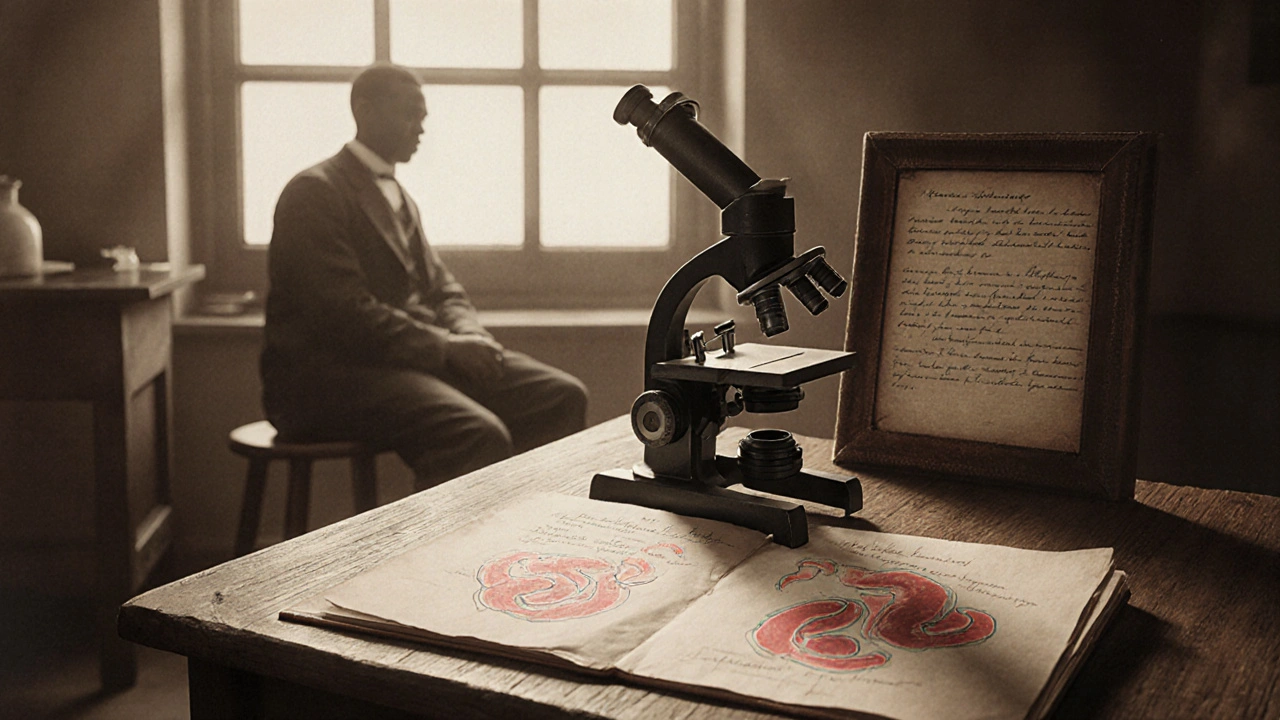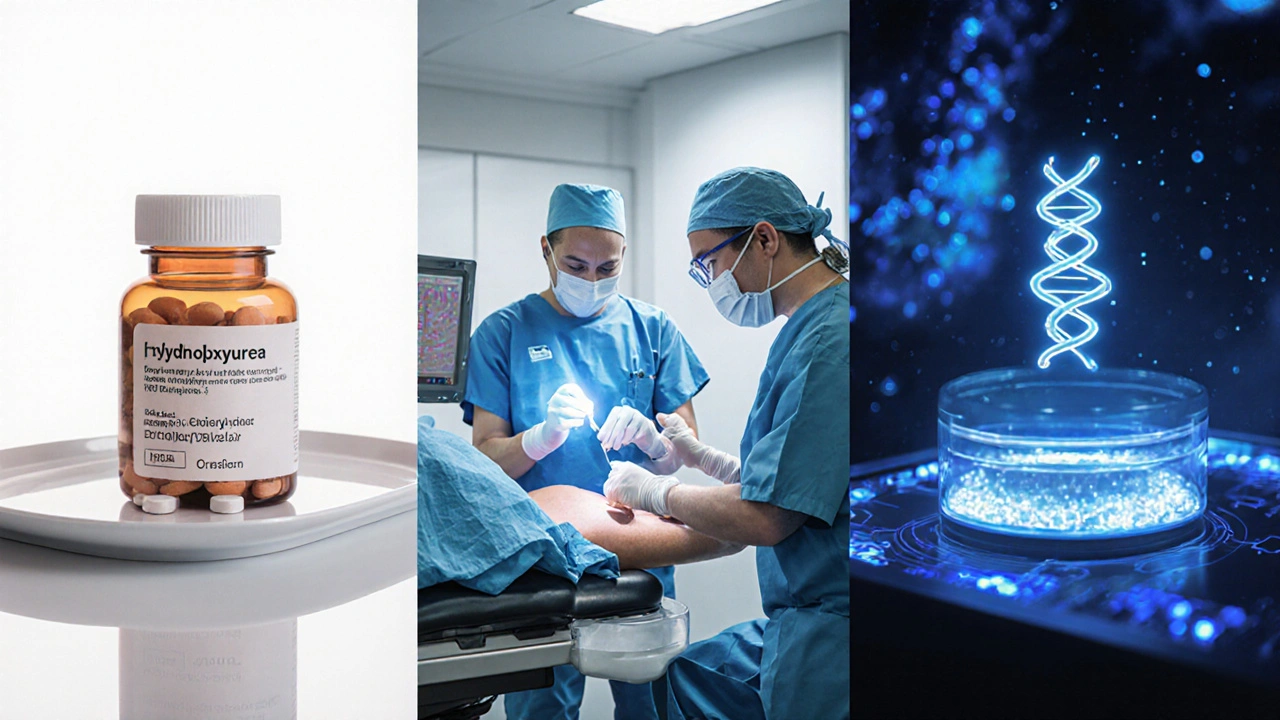Sickle Cell Anemia History: Discovery, Milestones, and Modern Treatments
 Oct, 1 2025
Oct, 1 2025
Sickle Cell Anemia Timeline & Treatment Explorer
Historical Timeline
1910
James Herrick describes sickle-shaped cells in a patient, coining the term "sickle cell anemia"
1949
Linus Pauling identifies Hemoglobin S as the cause of sickle cell disease
1950s-1970s
Discovery of heterozygote advantage explains persistence in malaria-endemic regions
1998
Hydroxyurea approved as first disease-modifying therapy
2000s-2015
Bone marrow transplants become viable curative option
2017-2025
Gene therapy emerges as potential cure with CRISPR and lentiviral approaches
Treatment Comparison
Hydroxyurea
Mechanism: Increases fetal hemoglobin to inhibit HbS polymerization
Cost: ~$1,200/year
Risks: Myelosuppression, skin ulcers
Bone Marrow Transplant
Mechanism: Replaces defective stem cells with healthy donor cells
Cost: ~$200,000-$400,000
Risks: Graft-versus-host disease, infection
Gene Therapy
Mechanism: Adds or corrects β-globin gene in patient's stem cells
Cost: ~$1.5 million
Risks: Insertional mutagenesis, off-target edits
Did You Know?
The mutation causing sickle cell anemia provides protection against malaria, explaining why it persists in certain populations.
Quick Facts
- Over 300,000 babies are born with sickle cell disease annually
- Most cases occur in low-resource settings
- Hydroxyurea is the first disease-modifying drug approved for sickle cell disease
- Gene therapy represents a potential cure for patients without suitable donors
- World Health Organization estimates 90% of cases occur in sub-Saharan Africa
When you hear the term Sickle cell anemia is a genetic blood disorder that causes red blood cells to assume a rigid, sickle‑shaped form, leading to painful crises, organ damage, and reduced life expectancy. Its story stretches from ancient art on Egyptian tomb walls to cutting‑edge gene‑editing labs. Understanding how scientists moved from a baffling clinical observation to lifesaving therapies helps patients, families, and anyone curious about why a single mutation can shape health policy worldwide.
Key Takeaways
- James Herrick first described sickle‑shaped cells in 1910, coining the term "sickle cell anemia."
- Linus Pauling proved in 1949 that the disease is caused by an abnormal form of hemoglobin called Hemoglobin S.
- The discovery of the malaria‑protective heterozygote advantage explained why the mutation persisted in certain populations.
- Hydroxyurea, approved in 1998, was the first drug to target the disease mechanism rather than just symptoms.
- Gene‑editing trials in the 2020s are moving the field toward a potential cure.
Early Clues Before Modern Medicine
Evidence that something odd was happening to people of African descent appears in art from the Old Kingdom of Egypt (c.2500BC). Tomb paintings show individuals with swollen limbs and facial deformities that match severe sickle‑cell crises. Greek physicians noted that some slaves from the "Dark‑skinned" regions of the world suffered from "anemia," but no biochemical explanation existed.
The First Clinical Description (1910‑1940)
In 1910, American physician James Herrick examined a Black dental student who complained of severe fatigue. Under the microscope, Herrick saw red cells bent like a sickle and wrote a short note in the Archives of Internal Medicine calling the condition "peculiar elongated cells" and suggesting a hereditary anemia.
Herrick’s observation sparked debate for decades. Without a way to measure hemoglobin directly, doctors could only label the disease as "sickle‑cell disease" or "sickle‑cell anemia" based on morphology.
Biochemical Breakthrough: Hemoglobin S (1949)
Enter Linus Pauling, the Nobel‑winning chemist who loved linking genetics to chemistry. In 1949 he published a landmark paper showing that sickle‑cell patients carried a variant form of hemoglobin that migrated differently on electrophoresis. He named this abnormal protein Hemoglobin S (HbS). This was the first time a disease was traced to a single molecular change - a single point mutation in the β‑globin gene.
Pauling’s work coined the phrase "molecular medicine" and proved that a genetic mutation could alter protein structure, cell shape, and ultimately health.
Genetics and Evolutionary Insight (1950s‑1970s)
By the 1950s, researchers like J. B. Perkins demonstrated the autosomal recessive inheritance pattern: two copies of the HbS gene produce full‑blown disease, while one copy offers resistance to severe malaria. This "heterozygote advantage" explained why the mutation remained prevalent in sub‑Saharan Africa, the Mediterranean, the Middle East, and parts of India.
Population studies led the World Health Organization to estimate that over 300,000 babies are born with sickle‑cell disease each year, most in low‑resource settings.
Supportive Care Era (1960s‑1980s)
Before disease‑modifying drugs, treatment focused on managing crises:
- Regular blood transfusions to dilute sickled cells.
- Penicillin prophylaxis in children to prevent pneumococcal infections.
- Hydration and pain‑management protocols using opioids.
These measures extended life expectancy modestly but did not address the underlying sickling process.

Hydroxyurea: The First Disease‑Modifying Therapy (1998)
In the early 1990s, Dr. {"name":"Donella L. T."} discovered that the chemotherapy drug hydroxyurea increased fetal hemoglobin (HbF) levels, which interferes with HbS polymerization. A landmark 1995 NIH trial showed a 40% reduction in painful episodes among adults.
The U.S. Food and Drug Administration granted approval in 1998, making hydroxyurea the first medication to target the disease mechanism. Today, guidelines recommend hydroxyurea for most patients over 9 months old, provided they have regular monitoring of blood counts.
Bone Marrow (Stem‑Cell) Transplant: A Curative Option (2000‑2015)
The first successful allogeneic bone‑marrow transplant for sickle‑cell disease was performed in 1984, but it remained experimental because of high transplant‑related mortality. Advances in HLA matching, reduced‑intensity conditioning, and improved supportive care lowered mortality to under 10% by 2010.
Transplant is currently considered for patients with severe disease who have a matched sibling donor. The procedure replaces the patient’s defective hematopoietic stem cells with healthy ones, effectively eliminating sickling.
Gene Therapy: From Concept to Clinical Reality (2017‑2025)
Two main gene‑therapy strategies dominate the field:
- Lentiviral addition: A modified virus inserts a functional β‑globin gene (often called “β‑A‑T87Q”) into the patient’s own stem cells. The FDA approved the first such therapy, beti‑cel, in November 2022.
- CRISPR‑based editing: The CRISPR‑Cas9 system directly repairs the HbS mutation or reactivates fetal hemoglobin production. Early phase I/II trials reported 80% of participants achieving transfusion independence by 2024.
Typical costs exceed $1.5million per patient, but insurers in the U.S. and EU are beginning to negotiate bundled payments as long‑term outcomes improve.
Current Standard of Care (2025)
Today a patient’s treatment plan often blends several modalities:
- Hydroxyurea as first‑line disease‑modifying drug.
- Annual transcranial Doppler screening for stroke risk in children.
- Chronic transfusion programs for high‑risk organ damage.
- Eligibility assessment for curative options (bone‑marrow transplant or gene therapy).
Tele‑medicine platforms now allow remote monitoring of hemoglobin levels and pain episodes, improving adherence and early intervention.
Checklist for Patients and Caregivers
- Know your genotype (SS, SC, Sβ⁰, Sβ⁺) - it guides treatment intensity.
- Keep a pain‑diary; patterns help clinicians adjust hydroxyurea dosage.
- Schedule blood counts every 4‑8weeks when on hydroxyurea.
- Vaccinate against pneumococcus, meningococcus, and influenza.
- Discuss curative options early - donor availability can change over time.
Comparison of Major Treatments
| Treatment | Mechanism | FDA Approval Year | Typical Candidates | Major Risks | Approx. Cost (US$) |
|---|---|---|---|---|---|
| Hydroxyurea | Increases fetal hemoglobin (HbF) to inhibit HbS polymerization | 1998 | Most patients ≥9months old with moderate disease | Myelosuppression, skin ulcers | ~$1,200/year |
| Bone‑marrow transplant | Replaces defective hematopoietic stem cells with healthy donor cells | 1990 (experimental), widely accepted 2009 | Severe disease + HLA‑matched sibling donor | Graft‑versus‑host disease, infection, organ toxicity | ~$200,000-$400,000 |
| Gene therapy (lentiviral or CRISPR) | Adds or corrects β‑globin gene to patient's stem cells | 2022 (lentiviral), 2024 (CRISPR trials) | Patients lacking donors, or those seeking permanent cure | Insertional mutagenesis, off‑target edits, high cost | ~$1.5million |
Future Directions
Researchers are now testing base‑editing tools that can swap the single nucleotide causing HbS without cutting DNA, which could dramatically reduce off‑target effects. At the same time, global health initiatives aim to scale hydroxyurea distribution in sub‑Saharan Africa, where more than 70% of births with sickle‑cell disease occur.
Long‑term, the hope is a world where newborn screening, inexpensive disease‑modifying drugs, and a single‑dose curative gene edit together eliminate sickle‑cell morbidity.

Frequently Asked Questions
What causes sickle cell anemia?
It’s caused by a single point mutation (GAG → GTG) in the β‑globin gene that creates Hemoglobin S. The altered hemoglobin polymerizes when oxygen is low, forcing red cells into a sickle shape.
How is sickle cell diagnosed?
Newborn screening uses high‑performance liquid chromatography or electrophoresis to detect HbS. Confirmatory DNA testing can identify specific mutations.
Can hydroxyurea cure sickle cell?
No. Hydroxyurea reduces the frequency of pain crises and delays organ damage, but patients remain genetically predisposed. A true cure requires replacing the defective stem cells, which is what transplants or gene therapy aim to do.
Who is eligible for bone‑marrow transplant?
Eligibility depends on disease severity, age (usually under 30), and availability of an HLA‑matched sibling donor. Patients without a matched sibling may explore unrelated donor registries or haplo‑identical transplants.
Is gene therapy widely available?
As of 2025, gene therapy is approved in the U.S. and EU but is limited to specialized centers. High cost and the need for autologous stem‑cell collection restrict broad access, though pilot programs aim to reduce these barriers.

Jamie Balish
October 1, 2025 AT 17:46This timeline beautifully captures the evolution of sickle‑cell research from the early 1900s to modern gene‑editing breakthroughs. It reminds us that every scientific milestone rests on the curiosity of a handful of dedicated individuals. When James Herrick first described those peculiar elongated cells, he could not have imagined the global impact his observation would have. Linus Pauling’s identification of Hemoglobin S introduced the concept that a single amino‑acid substitution can reshape an entire disease landscape. The recognition of the heterozygote advantage taught us how evolution can preserve a harmful mutation because of malaria resistance, a fascinating trade‑off that still informs public‑health strategies today. The approval of hydroxyurea in 1998 marked the first time we could target the molecular cause rather than just manage symptoms, giving patients a tangible tool to reduce painful crises. Subsequent advances in bone‑marrow transplantation showed that replacement of defective stem cells could be curative for a select group, inspiring hope for more inclusive therapies. Gene‑editing technologies, especially CRISPR‑based approaches, are now moving us toward a future where a single outpatient procedure could correct the mutation for millions. Yet we must remember that accessibility remains a huge challenge, particularly in sub‑Saharan Africa where the burden is highest. Community‑based programs that distribute hydroxyurea at low cost are essential bridges while we await broader gene‑therapy rollout. The timeline also highlights the importance of newborn screening, which can catch the disease early and start interventions before irreversible damage occurs. Multidisciplinary care teams that include hematologists, pain specialists, and mental‑health professionals improve quality‑of‑life outcomes beyond what any single drug can achieve. Ongoing research into base‑editing promises even safer corrections with fewer off‑target effects, a technical refinement that could accelerate regulatory approvals. Collaboration across academia, industry, and patient advocacy groups has been the engine driving these advances, and it must continue to thrive. As we look forward, let us keep celebrating both the scientific triumphs and the everyday heroes-patients, families, and clinicians-who keep the momentum going. Together, we can transform a once‑fatal disease into a manageable condition and, eventually, a curable one.
Jeff Bellingham
October 1, 2025 AT 19:10The historical overview is accurate; however, the cost figures for gene therapy require updating to reflect recent market adjustments.
Matthew Balbuena
October 1, 2025 AT 21:56Wow, that's a real eye‑opener! The way they laid out the whole saga from ancient Egyptian art to CRISPR is just mind‑blowin', ya know? I love the mix of science and history – it’s like a time‑travelin' scrapbook.
michael abrefa busia
October 1, 2025 AT 23:20Totally feel you, Matthew! 🌟 This stuff is wild and inspiring – makes me wanna dive into a lab! 🚀
Sharon Bruce
October 2, 2025 AT 02:06The United States has been at the forefront of sickle‑cell research, contributing many of the therapies highlighted here.
True Bryant
October 2, 2025 AT 04:53From a molecular pathology standpoint, the HbS polymerization kinetics represent a quintessential example of a gain‑of‑function missense mutation precipitating a cascade of hemolytic sequelae, underscoring the imperative for genotype‑guided therapeutic stratification. The advent of hydroxyurea illustrated how pharmacologic induction of fetal hemoglobin can modulate polymer formation, yet its myelosuppressive profile limits universal applicability. Allogeneic stem‑cell transplantation offers a definitive cure but brings graft‑versus‑host disease and donor‑availability constraints into sharp focus. Emerging lentiviral vector platforms aim to rectify the beta‑globin locus while preserving regulatory elements, a strategy that may circumvent previous insertional oncogenesis concerns. Meanwhile, CRISPR‑Cas9 mediated base‑editing promises single‑nucleotide precision with a considerably reduced off‑target burden, heralding a potential paradigm shift. Ultimately, the confluence of these modalities reflects a broader trend toward personalized, curative interventions in hematology.
Danielle Greco
October 2, 2025 AT 07:40Great synthesis, True! 🎉 It’s impressive how each approach tackles a different facet of the disease, and the future looks promising. Keep the science rolling! 😊
Beth Lyon
October 2, 2025 AT 10:26I think the timeline is great but some info is to old.
Nondumiso Sotsaka
October 2, 2025 AT 13:13Thank you for sharing this! 🙏 Keeping the community informed helps us all stay hopeful and motivated.
Ashley Allen
October 2, 2025 AT 16:00Great overview.
Brufsky Oxford
October 2, 2025 AT 18:46Contemplating the arc from ancient sketches to gene‑editing, one sees humanity’s relentless quest to rewrite destiny, a narrative as timeless as the stars. :)